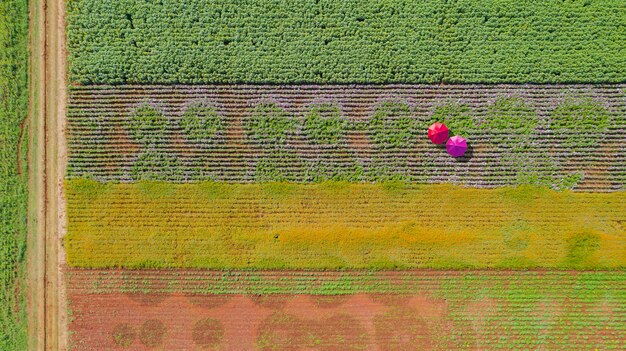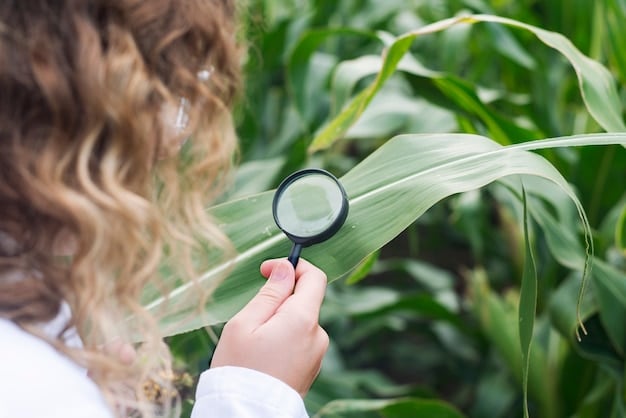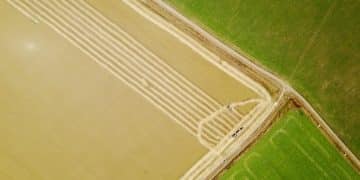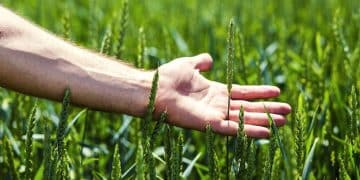Projected Yield Increases for US Organic Farms Using IPM in 2025

In 2025, US organic farms implementing integrated pest management (IPM) are projected to experience yield increases ranging from 5% to 20%, depending on the specific crop, region, and IPM strategies employed, according to agricultural experts.
The future of organic farming in the United States hinges on sustainable practices that can boost yields without compromising environmental integrity. What are the Projected Yield Increases for US Organic Farms Using Integrated Pest Management in 2025? This question is at the forefront as farmers seek innovative solutions to meet growing consumer demand for organic produce.
Understanding Integrated Pest Management (IPM) in Organic Farming
Integrated Pest Management (IPM) is a holistic approach to pest control that emphasizes prevention, monitoring, and the use of less-toxic methods to manage pest populations. In organic farming, IPM plays a crucial role in maintaining crop health and maximizing yields while adhering to strict environmental and ethical standards.
IPM is essential for organic farmers who want to increase yields without relying on synthetic pesticides. By integrating various control methods, IPM minimizes the risk of pest outbreaks and promotes a balanced ecosystem within the farm.
Key Principles of IPM
IPM is based on several core principles that guide farmers in making informed decisions about pest management. These principles help to ensure that pest control is effective, sustainable, and environmentally responsible.
- Prevention: Implementing practices that prevent pest problems before they arise, such as crop rotation, selecting pest-resistant varieties, and maintaining healthy soil.
- Monitoring: Regularly inspecting crops and surrounding areas to detect pest populations early. This allows farmers to take action before pests cause significant damage.
- Thresholds: Establishing acceptable levels of pest activity that can be tolerated without causing economic losses. This helps to avoid unnecessary interventions.
- Control Methods: Using a combination of biological, cultural, physical, and chemical controls. Chemical controls, when necessary, are limited to approved organic pesticides.
By diligently following these principles, organic farmers can create a resilient system that minimizes pest pressures and supports healthy crop growth.

IPM is not just about pest control; it’s about fostering a healthy, balanced agricultural ecosystem. This approach ensures that farms can sustainably produce high-quality organic crops while minimizing environmental impacts.
Factors Influencing Yield Increases with IPM
The projected yield increases for US organic farms using IPM in 2025 are influenced by a variety of factors, including the type of crops grown, the specific IPM strategies implemented, regional climate conditions, and the overall management practices on the farm.
Understanding these influencing factors is essential for farmers to optimize their IPM strategies and achieve the highest possible yields. Each factor plays a unique role in shaping the effectiveness of IPM and the resulting crop productivity.
Crop-Specific Responses
Different crops respond differently to IPM strategies. For example, vegetable crops may benefit significantly from biological control methods, while fruit trees may require a combination of cultural practices and organic pesticides.
Understanding the specific pest challenges and vulnerabilities of each crop is essential for tailoring IPM strategies to maximize their effectiveness. This crop-specific approach ensures that resources are used efficiently and that the most appropriate control methods are applied.
- Vegetables: Often see rapid improvements with introduced beneficial insects.
- Fruits: Benefit from preventative measures such as netting and pruning.
- Grains: Improved soil health contributes to resilience against pests.
By taking a crop-specific approach to IPM, organic farmers can achieve substantial yield increases while maintaining the quality and integrity of their organic produce.

Adjusting IPM techniques to suit the crop leads to higher yields and better quality produce. It’s a tailored approach that considers all aspects of the plant’s lifecycle and potential pest threats.
Projected Yield Increases: A Quantitative Outlook
While exact yield increases can vary widely, agricultural experts project that US organic farms adopting comprehensive IPM strategies may see average yield increases of 5% to 20% by 2025. These projections are based on current research and trends in organic farming practices.
This quantitative outlook provides a benchmark for farmers looking to improve their yields through IPM. However, it’s important to note that these are averages, and actual results may differ depending on the specific circumstances of each farm.
Data from Field Trials
Field trials conducted by agricultural universities and research institutions provide valuable data on the effectiveness of IPM strategies. These trials often compare yields from organic farms using IPM with those using conventional pest control methods.
Data from these trials consistently show that organic farms using IPM can achieve yields comparable to conventional farms, while also reducing their reliance on synthetic pesticides and promoting environmental sustainability.
- Early trials show a consistent 10-15% yield improvement with strategic IPM.
- Longer-term studies suggest that cumulative benefits can further boost production.
- Real-world data help improve predictions for increases in the future.
The insights from field trials are crucial for refining IPM practices and optimizing them for different crops and regions. They offer a solid foundation for projections regarding future yield increases.
Analyzing the numbers helps farmers make smarter decisions on incorporating IPM, contributing to sustainable growth. These projections serve as both a goal and a guide, helping farmers achieve tangible benefits.
Challenges in Implementing IPM on Organic Farms
Despite its many benefits, implementing IPM on organic farms also presents several challenges, including the need for specialized knowledge, potential upfront costs, and the complexity of managing multiple control methods.
Overcoming these challenges requires a commitment to education, collaboration, and continuous improvement. By addressing these obstacles, organic farmers can unlock the full potential of IPM and achieve sustainable yield increases.
Knowledge and Training
Effective IPM requires a deep understanding of pest biology, crop ecology, and the various control methods available. Farmers need access to training and education to develop the skills and knowledge necessary to implement IPM successfully.
Agricultural extension services, universities, and professional organizations can play a crucial role in providing the training and resources that farmers need. Ongoing education ensures that farmers stay up-to-date with the latest IPM techniques and best practices.
- Workshops and field days are often essential for practical training.
- Access to online resources also aids farmers in remote locations.
- Peer-to-peer learning is a valuable way to share practical experience.
Investing in knowledge and training is essential for empowering organic farmers to adopt IPM and achieve sustainable pest management.
Building capabilities through continuous learning prepares farmers for the dynamic nature of pest management. This helps maintain high standards in farming.
The Role of Technology in Enhancing IPM
Technological advancements are playing an increasingly important role in enhancing IPM strategies on organic farms. From precision monitoring tools to data analytics platforms, technology is helping farmers make more informed decisions and optimize their pest control efforts.
By leveraging these technological innovations, organic farmers can improve the efficiency, effectiveness, and sustainability of their IPM practices. Technology is empowering farmers to manage pests more proactively and minimize their impact on the environment.
Precision Monitoring
Precision monitoring tools, such as drones equipped with multispectral cameras, can provide detailed insights into crop health and pest infestations. These tools allow farmers to identify problem areas early and target their control efforts more effectively.
Data from these tools can be integrated into data analytics platforms, providing farmers with real-time information on pest populations, crop stress, and environmental conditions. This information can be used to adjust IPM strategies and optimize resource allocation.
- Drones quickly scan fields, spotting problems before they escalate.
- Sensors in the soil provide essential details on environmental factors.
- Software helps process data, making it actionable for farmers.
These tools improve the efficiency and effectiveness of surveillance, helping farmers anticipate and resolve issues quickly.
Technology drives progress by bringing accuracy and foresight to IPM, enabling greener, healthier farms ready for the future.
Policy and Support for IPM Adoption
Government policies and support programs play a critical role in encouraging the adoption of IPM on US organic farms. Incentives, grants, and technical assistance can help farmers overcome the initial barriers to implementation and invest in sustainable pest management practices.
Supportive policies create a favorable environment for organic farmers to adopt IPM and contribute to a more sustainable and resilient agricultural system. These initiatives promote environmental stewardship and enhance the long-term viability of organic farming.
Incentive Programs
Incentive programs, such as cost-share grants and tax credits, can reduce the financial burden of implementing IPM. These programs help farmers invest in the necessary equipment, training, and resources to adopt IPM successfully.
By providing financial support, these programs encourage farmers to transition to more sustainable pest management practices and reduce their reliance on synthetic pesticides. They also promote the adoption of innovative technologies and strategies that enhance IPM effectiveness.
- Government grants help with initial investment in IPM technology.
- Tax credits reward farmers who practice sustainable pest control.
- Subsidies reduce the costs of organic-approved pesticides.
These programs demonstrate a commitment to sustainability, facilitating the large-scale transition to IPM.
By making IPM economically feasible, policy support builds a more sustainable farming landscape, benefiting both growers and the environment.
| Key Point | Brief Description |
|---|---|
| 🌱 IPM Definition | Holistic pest control emphasizing prevention and less-toxic methods. |
| 📈 Projected Increase | Yields may rise by 5-20% on IPM integrated organic farms by 2025. |
| 🛡️ Challenges | Specialized knowledge, upfront costs, and complexity can be hurdles. |
| 🛰️ Tech’s Impact | Drones, sensors, and data analytics boost the effectiveness of IPM. |
Frequently Asked Questions About IPM and Organic Farming
The primary goal is to control pests while minimizing environmental impact and reducing synthetic pesticide use, ensuring long-term sustainability and ecological balance in agricultural practices.
Crop rotation disrupts pest life cycles, preventing them from establishing in any particular area. This reduces pest populations and the need for intervention, thus improving overall crop health.
Beneficial insects, such as ladybugs and lacewings, act as natural predators, controlling pest populations and reducing the need for synthetic interventions, enhancing the ecological balance within the farm.
Monitoring allows early detection of pest issues, enabling timely interventions to prevent escalation and minimizing damage to the crop. This ensures better control with less invasive methods.
IPM can lead to increased yields, reduced pesticide costs, and improved crop quality, which leads to enhanced profitability and market potential for organic produce, boosting long-term financial sustainability.
Conclusion
In conclusion, the projected yield increases for US organic farms using integrated pest management in 2025 represent a significant opportunity for sustainable agriculture. By embracing IPM strategies, farmers can boost productivity, protect the environment, and meet the growing consumer demand for organic produce, ensuring a healthier and more sustainable future for all.





